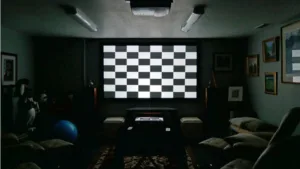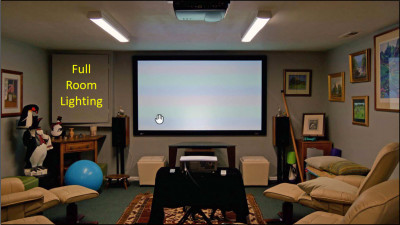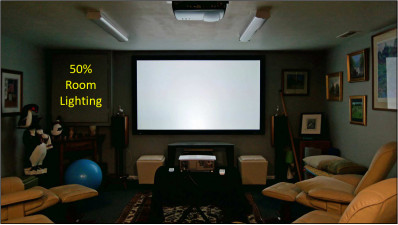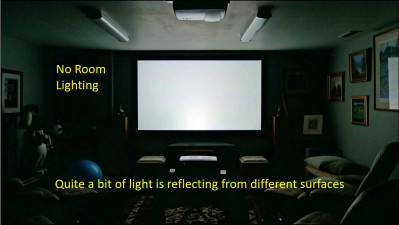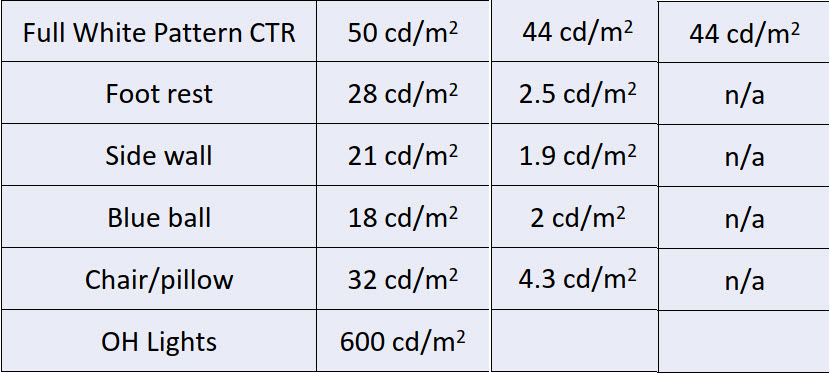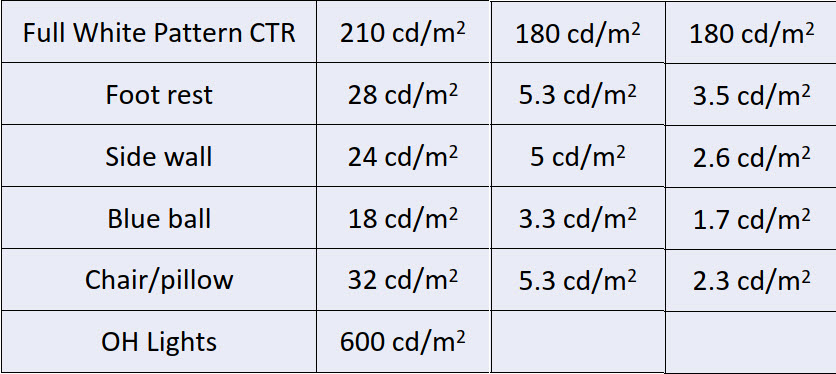
He then went on to ask “Should we be focussing on screen contrast, instead?”. He highlighted that, in the past, it was always tricky to make really bright displays – CRTs were just around 100 cd/m² and cinema screens struggled to hit the SMPTE recommendation of 16 ft-L (55 cd/m²).
These days, he said, TVs can crank out 300 -1000 cd/m² (well, I’ve seen some up to 2,000! – editor) and projectors up to 50K lumens, while small pitch LEDs can put out 3,000 cd/m². Do we really need them to be that bright?
It depends on the application. Outdoor LEDs have to be bright to catch your attention, and are not for sustained viewing. The sky can get up to 100K cd/m² – you need a lot of light to compete.
Focus on Contrast
Instead of focusing on the light, Putman said, it’s better to focus on the contrast ratio and in particular the limiting contrast ratio between the image on the screen and the ambient and reflected light in the viewing space. He gave some AV industry “rules of thumb”:
- For passive viewing (reading a book/magazine): 7:1 minimum
- For classroom / meeting room presentations: 15:1 minimum
- For analytical decision making: 50:1 minimum
- For immersive viewing (movies, VR, etc): 80:1 minimum
These are targets rather than fixed ‘rules’ but getting past 50:1 can be tricky. Either way, working this way, you only pay for the luminance you need.
The Calculations
The ‘black’ level in the room is set by ambient light and so the light target is the black level multiplied by the contrast ratio desired. Light meters work in lux, rather than lumens, so for calculation, you need to multiply the lux by the screen area (in sq metres). He gave this calculation for a classroom.
- Ambient light in a classroom measures 100 lux
- 16:10 screen measures 120 inches diagonally (4.175 m² area)
- 100 lux (x) 4.175 = 417.5 lumens (this is the effective ambient ‘black’ level)
- Recommended contrast ratio for classrooms = 15:1
- 417.5 (x) 15 = 6262.5 lumens
- Use a 6000-lumens projector with a matte (1.0) screen
That’s a pretty clear calculation for a projection system.
For a direct view display (e.g. LCD or OLED or LED), at the same size (120″ – that’s a big one!):
- 4.175 m2 = 45 ft² screen area
- We’d need a 120-inch LCD, OLED, or ILED display (heavy and $$$$!)
- 6000 lumens / 45 ft² screen = 133 ft-L
- 133 ft-L = 455 cd/m², which is a very bright display
- But, limiting contrast ratio is only 15:1– there should be no eye strain with comfortable viewing
- In a dark room, this could create visual fatigue after sustained viewing
If the room is darker, you don’t need so much light. He looked at his own (old) projector, which is rated at 1,000 lumens but is only 300 lumens after calibration. There is lots of ambient light and also reflections when the lights are on, even though the walls were painted grey.
Check the images above for full, half and no room lighting.
The measurements of the black level and the brightness of objects varied a lot between the three lighting situations. The first column shows measurements with all the lighting on, the second with the front lights off and the right with all off.
Putman then went through the calculations to show that what he measured matched what he would expect from the projector, but couldn’t quantify the limiting contrast ratio as the meter he was using could not measure the darkest regions. However, in the darkest setting, the image was good enough for viewing.
He switched to a newer brighter projector (from BenQ). This looked a lot brighter when the lights were on, but didn’t improve so much when all the lights were off as there was a lot of reflection from the room.
Looking at those results, it’s clear that the BenQ W1500 projector is a lot brighter at 1300 lumens and the full white has much more luminance. However, the limiting contrast is 51:1 because of the reflections, which is good but not great. You need a darker room with viewers with darker clothes (and a darker cat!).
The BenQ projector is brighter than the old one, but the light from the screen cause the room surfaces to be more obvious.
Many years ago, it was stated by Milliken that 50 ft-L (171 cd/m²) is a practical upper limit for displays in a darkened room, but Putman thinks this may be too bright. He attended a test of a 3.3mm pitch LED wall in a large theatre that had 200 cd/m² (58 ft-L) full white, but some viewers, well away from the screen, thought it was too bright for comfort.
TVs can be too bright, too. His LG OLED is around 130 cd/m² (38 ft-L) when ISF calibrated, and in daytime you get 2:1 to 10:1 contrast which is comfortable. However, at night, it lights up the whole room but at about 65:1 limiting contrast ratio – good but not perfect for immersive viewing.
However, we’re now moving into the era of LED TVs and Samsung’s 144″ (12’/366cm diagonal) Wall TV can provide full brightness of 1,600 cd/m² (468 ft-L) at full white which, with a typical Average Picture Level (APL), would mean on-screen images of 100-300 cd/m² (29-88 ft–L). Again, some viewers found the image too bright for long term viewing. As he said
“It can really crank out the photons”
The high brightness means that the room is lit up well enough to write notes and he said that to watch one HDR clip, he ended up with sunglasses on!
LEDs are already moving into cinemas. However, even ‘throttled’ back, with HDR content, on-screen brightness was up to 200 cd/m² and the whole cinema was ‘lit up’. It did make it easy for staff to deliver food and drink, but the trainers on one viewer (shown in the image below) measured 10 ft-L!
In conclusion:
- Displays are bright enough now
- They can be too bright for comfort
- Milliken’s recommendation of 1998 that 50 ft-L/188 cd/m² is enough is still valid
- The best way to get good value is to work back from the target contrast ratio
- The best way to get good results is from changes to the viewing space, not by simply cranking up the display luminance.
- There is still a challenge to get to 80:1 in most environments.
(BR)

